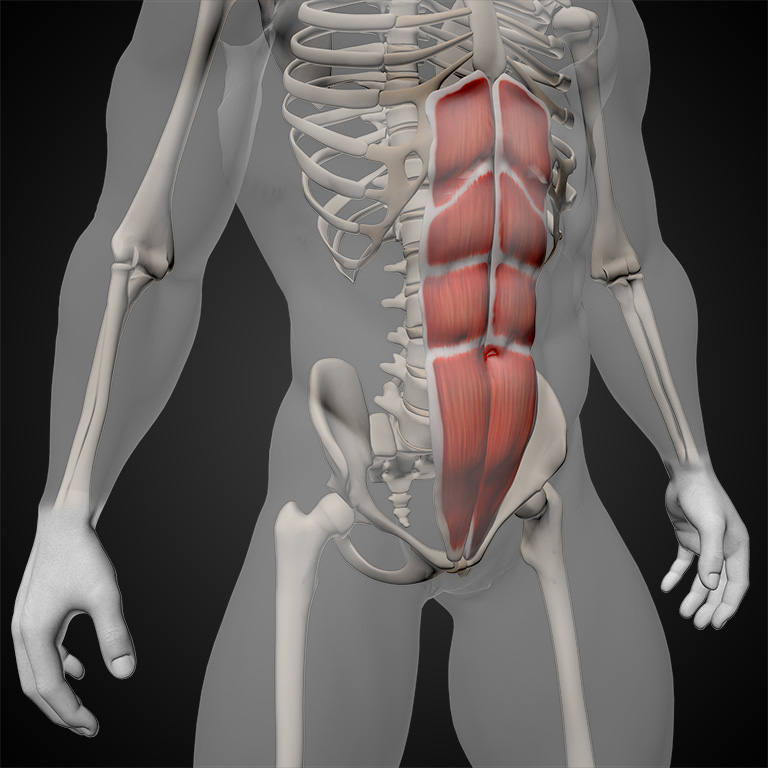Welcome to Mean Muscles’ core training category. Before we dig into any specific workouts, we want to make something clear- The difference between abs and core.
Now, if you are a beginner trainee and haven’t studied the human anatomy all that much, there might be no difference for you. However, when you understand it, there is actually a significant difference.
In this article, we will talk about the basic anatomy, which is quite useful, especially when you’re trying to reach your goals in a straight line.
The Six-Pack
Odds are that if you are a beginner trainee, your main goal is having well-shaped abs. Having a six-pack pretty much gives you a different status and that’s exactly why it is sought by so many people.
Now, the six-pack, often referred to as “abs” is one single muscle group, called the “Rectus Abdominis”, as showcased below.

However, the CORE, or otherwise said, the abdominal muscles, are in fact a group of muscles. To be specific, that is a group of 6 muscle groups.
Besides making you look cool, those core muscles have actual functions
- Breathing assistance
- Maintaining internal organ position
- Spinal support during physical activities
Essentially, the six-pack, or the “abs” are targeted when the trainee performs a basic, crunching exercise- Standing, hanging or lying on the floor.
On the flipside, we have the core muscles, which are basically the torso muscles, that are engaged during dynamic activities that require stabilization of the body.
Abs vs Core
So, now we know the difference- Abs are one single muscle group, while the core is a group of muscles, including the abs. The main core muscles are the abs, obliques, mid & lower back, as well as the glutes.
Next time you do an exercise in the gym, such as the cable triceps pushdowns, try to feel your core engaging- When it does so, it is stabilizing the movement, allowing you to stay in a static, upright position.
As opposed to the abs, that only have a single function, the core is way more functional. To say the least, the core also includes muscles that are deep and often, unknown or ignored for most trainees.
That is to say that you’ll rarely see someone training their transverse abdominals, pelvic muscles or even the diaphragm. More often, you will see people just doing crunches and leg raises to target the visible, cool-looking muscles.
So, if we consider the abs and lower back muscles to be “antagonists”, we will conclude that simple, crunching movements would be good for the first, while hyperextensions would be perfect to target the lower back muscles.
Needless to say, however, we must never ignore the core, which is why it would be adequate to include core-engaging exercises like deadlifts and planks in your training routine.
As compared to people that only train their “six-pack”, athletes that target the core well, are way more stable and balanced during dynamic physical activity. On top of that, having a strong core is certainly a preventative measure for many injuries, linked to weakly developed core musculature.
So, which should you train?
Actually, we’re not telling you to ignore your abs, as they are a part of the core and play a big role in the support of your spine and correct body posture.
On top of that, when it comes to body composition and how you look, tight abs will certainly make your belly look good, if, of course there isn’t a substantial amount of fat covering your four/six/eight-pack.
As abs are a big muscle group, making them strong will certainly help your back support as well.
What we want to emphasize on however, is the fact that you should not PRIMARILY train abs, with a six-pack idea in mind.
Instead, focus on your whole core to get the most out of its supporting functions and looks.
If your main goal is having six-pack abs, it would be also a good idea to consider implementing changes in your diet. The main factor behind having a good, well defined belly is not how many crunches you will do, but rather what your body fat percentage is.
Conclusion
So, if you really want a good-looking, functional belly, don’t just spam crunches all day long! Understand the anatomy, make use of the muscles’ functions and treat yourself with proper nutrition.
Strength, functionality, looks. Move on to our core workouts.

